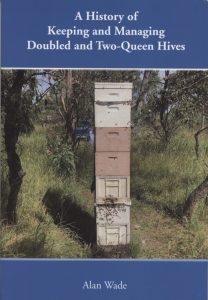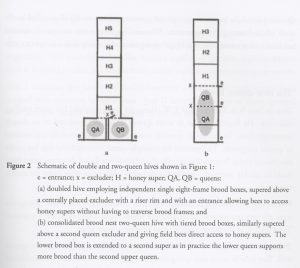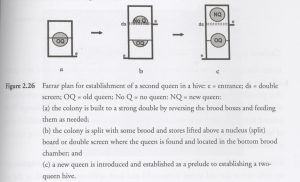 A History of Keeping and Managing Doubled and Two-Queen Hives, by Alan Wade. Published by Northern Bee Books, UK, 6.5” x 9.5”, 169 pgs., color throughout, $28.00 from Amazon.
A History of Keeping and Managing Doubled and Two-Queen Hives, by Alan Wade. Published by Northern Bee Books, UK, 6.5” x 9.5”, 169 pgs., color throughout, $28.00 from Amazon.
If you have run two queen colonies, or are now, you pretty much know all the management techniques you need to make it work. But this book covers more than one way to do this, so you might learn something anyway. It is, as the title states, a history of the techniques it covers. And it’s an interesting history.
Basically, the author looks at what is called a doubled colony, where the two brood nests sit side-by-side on the ground. A single shared excluder covers half of each brood nest below, and the single column shared honey supers are stacked above. Each brood nest has its own entrance facing opposite sides. Since the excluder only covers some of the frames of each brood nestt, the portion of the cover that does not have honey supers sitting on it is removable for access to the brood frames below. There often is no entrance to the honey supers except from the brood boxes below.
Some of the original models were designed so that the bottom broodnests were actually in a single box, with a wall between and an excluder covering both above. Honey supers above were the same dimension as the broodnext box below the excluder. A more extensive technique was to use three boxes for three individual brood nests, a shared excluder covered all three, and two off set honey supers above, available to bees from all three colonies below. Since only part of each brood nest on the outside was covered by a stack of two honey supers above, a removable cover was used so each could be examined. Entrances were on opposite sides of the two outside boxes, and in the front for the middle brood nest. Of course all honey supers had to be removed to examine the middle brood nest. These were powerful honey producing machines.


The two queen colony is a bit more complicated, and requires a strong back, and often a ladder to reach the top of the colony. For this, the first queen’s two deep brood area sits on the ground, with an entrance on the bottom super and an excluder above the second box. Above that sits another queen’s broodnest of two deeps, an entrance on the opposite side, and an excluder above these two boxes. Above that shared honey supers are stacked. There are variations on this using more or fewer brood boxes for each, when to start both colonies and more, but this is a common technique often used.
The techniques and equipment used are fairly standard, but it was the history of the evolution of these I found most interesting. Many early developers were in the UK, which I knew nothing about, but several were from the US, Floyd Moeller from the Madison Bee Lab, and not so long ago John Hogg. Of course Tom Theobald from Colorado was a staunch supporter of these hives, and we have many photos with Tom on a ladder, supering a strong honey producing colony.
Perhaps the most valuable section of this book is the 32 page bibliography. It is, essentially, the history of the research, books, articles and more of using these hives. All in one place. This in itself is a valuable collection of information, certainly worthwhile to students of the art, and science, of beekeeping.
Kim Flottum
Growing Planet Media









